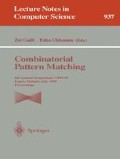Abstract
We examine a problem that arises in physical DNA mapping, namely determining what common DNA is represented in two maps. We first present an example illustrating the properties of DNA mapping, and present some biological background supporting our approach. We present a new graph structure, called the \(\mathcal{Z}\)-graph, that takes advantage of structure that develops during the mapping process, thus catalyzing the discovery of all maximum, topologically valid matchings. We describe an algorithm based on this structure and present experimental data supporting its improved performance as compared with a naive approach.
This work was supported by the James S. McDonnell Foundation under Grant 87-24 and NIH under grant R01 HG00180.
Preview
Unable to display preview. Download preview PDF.
References
James Daues and Will Gillett. DNA mapping algorithms: Fragment splitting and combining. Technical report, Washington University, Department of Computer Science, 1991. Report WUCS-91-50.
James Daues and Will Gillett. DNA mapping algorithms: Fragment matching mistake detection and correction. Technical report, Washington University, Department of Computer Science, 1993. Report WUCS-93-50.
Edsger W. Dijkstra. A Method of Programming. Addison-Wesley, 1988.
Heather A. Dury, Philip Green, Bridgid K. McCauley, Maynard V. Olson, David G. Politte, and Jr. Lewis J. Thomas. Spatial normalization of onedimensional electrophoretic gel images. Genetics, 8:119–126, 1990.
Will Gillett. DNA mapping algorithms: Strategies for single restriction enzyme and multiple restriction enzyme mapping. Technical report, Washington University, Department of Computer Science, 1992. Report WUCS-92-29.
Will Gillett, Jim Daues, Liz Hanks, and Rob Capra. Fragment collapsing and splitting while assembling high-resolution restriction maps. Journal of Computational Biology, 1995. In press.
Will Gillett, Liz Hanks, and Maynard Olson. Assembling high-resolution restriction maps using multiple complete digestions of a redundant set of clones. Genetics, 1995. Submitted.
Maynard V. Olson, James E. Dutchik, Madge Y. Graham, Garret M. Brodeur, Cynthia Helms, Mark Frank, Mia MacCollin, Robert Scheinman, and Thomas Frank. Random-clone strategy for genomic restriciton mapping in yeast. Proceedings of the National Academy of Science (Genetics), 83:7826–7830, October 1986.
Gwangsoo Rhee. Computational Models for DNA Restriction Mapping. PhD thesis, Washington University in St. Louis, 1990.
Linda Riles, James E. Dutchik, Amara Baktha, Brigid K. McCauley, Edward C. Thayer, Mary P. Leckie, Valerie V. Braden, Julie E. Depke, and Maynard V. Olson. Physical maps of the six smallest chromosomes of Saccharomyces cerevisiae at a resolution of 2.6 kilobase pairs. Genetics, 134:81–150, May 1993.
Jonathan S. Turner. The complexity of the shortest common matching string problem. Technical report, Washington University, Department of Computer Science, 1986. Report WUCS-86-9.
Jan Tijmen Udding and Tom Verhoeff. Using a parital order and a metric to analyze a recursive trace set equation. Technical report, Washington University, Department of Computer Science, 1988. Report WUCS-88-17.
Author information
Authors and Affiliations
Editor information
Rights and permissions
Copyright information
© 1995 Springer-Verlag Berlin Heidelberg
About this paper
Cite this paper
Hanks, L., Cytron, R.K., Gillett, W. (1995). An efficient algorithm for developing topologically valid matchings. In: Galil, Z., Ukkonen, E. (eds) Combinatorial Pattern Matching. CPM 1995. Lecture Notes in Computer Science, vol 937. Springer, Berlin, Heidelberg. https://doi.org/10.1007/3-540-60044-2_40
Download citation
DOI: https://doi.org/10.1007/3-540-60044-2_40
Published:
Publisher Name: Springer, Berlin, Heidelberg
Print ISBN: 978-3-540-60044-2
Online ISBN: 978-3-540-49412-6
eBook Packages: Springer Book Archive

